I've no idea why the shape of a cabinet would affect bass response. Volume is the only significant factor, right?
I ask this question because I've spent a lot of time trying fashion a subwoofer to fit under a bed. I think I'm currently embarking of MK VI.
Cabinet making is not my forte. So it's easier for to use a floor-standing tower cabinet as a base (25 litres). But on reflection I've never met a skinny floor-stander with an impressive bass response.
Has the shape got anything to do with it?
I ask this question because I've spent a lot of time trying fashion a subwoofer to fit under a bed. I think I'm currently embarking of MK VI.
Cabinet making is not my forte. So it's easier for to use a floor-standing tower cabinet as a base (25 litres). But on reflection I've never met a skinny floor-stander with an impressive bass response.
Has the shape got anything to do with it?
The answer is a good old-fashioned "maybe".
Theoretically, it shouldn't.
Practically, long and thin cabinets can exhibit resonances at midbass frequencies, and be subject to more panel flex if not properly-braced. So they could end up sounding different.
Theoretically, it shouldn't.
Practically, long and thin cabinets can exhibit resonances at midbass frequencies, and be subject to more panel flex if not properly-braced. So they could end up sounding different.
It can especially with radically unusual dimensions due to things like standing waves etc. Do you have a specific driver in mind? My instinct is that for a really thin like under the bed application a Transmission line design might be a good choice.
Does it need to fit entirely under the bed or can you have a small box beside the bed or behind the headboard?
Does it need to fit entirely under the bed or can you have a small box beside the bed or behind the headboard?
Absolutely and unreservedly yes. Non-cuboid shapes can push any panel resonances way out of the sub's pass band without the need for excessive bracing and panel damping. My undamped 15mm ply enclosures (18" 700W PA drivers and minimal volume damping) have their first significant panel resonance at over 500Hz. On a practical note, with sensible bracing a long flat enclosure will work adequately well, but don't expect significant output if you are using small drivers unless in multiples.
Move a lot of air - GENTLY!
Move a lot of air - GENTLY!
I have to add that I've done many tests with select cabinets (most recently Klipsch Heresy) that seem to have a weak bass output in an effort to see how much deeper I could get that cabinet to play.
I used a wide variety of 12" woofers and subs, 4 and 8 ohms, home and car speakers. Each driver has a very different design and calls for different volumes. Since the cabinet is sealed it offered a great test cabinet, just about every driver will work in a sealed can, it may not be their best situation per driver but al manufacturers have some type of sealed box spec.
Since the Heresy is known to hit that extreme 60Hz as its lowest usable frequency, you'd think swapping out any decent subwoofer will automatically make that 60Hz point become something that you'll never see as the lowest usable frequency.
Low and behold, the same lowest 60Hz kept appearing and the SPL at that 60hz was within 1 or 2 dbs across the board even an 8 ohms home woofer was nearly identical to the 4 ohm car sub.
Where I saw change was in the response after 60Hz as the test sweep got higher some drivers stayed flat (I tested from 20 to 200Hz close mic about 10" from the cone with mic on the ground aimed up at the center of each driver) I did the test at low volume to keep room interaction out of the results around 80db. Nothing within 5 feet in all directions to reflect or smear results.
I made a cabinet that was just slightly larger than the stock cabinet of dimensions 17"w x 14.5"d x 22"t compared to 15"w x 13"d x 21.5"t. As you can see the gain in volume was negligible but I had figured that the proportions had changed just enough to allow those same speakers to act differently.
The test results showed all drivers now were at 44.5Hz and around 75db. I have to conclude that as long as there's enough volume inside, the main factor that sets the cabinets lowest usable frequency (-6db point) is the proportions. I have read some high end manufacturers who sell speakers in the $40k range say during interviews that they know the magic key for ultimate bass output and it's a proportion factor and a shape.
Now you're thinking all you need to do is measure their cabinets, but you'd find that to be nearly impossible. Why? Because the shape of the speakers outside does not reflect what's inside the cabinet. Now you're thinking, just remove a driver and measure, right? Nope, at $40k they offer a lifetime warranty as long as it has not been altered by the owners. Now who would toss $40k out the window just to look inside of a cabinet and what would you do if the inside was more round or had a back passage that you couldn't see or reach?
They would not even give a hint but I'm thinking the old coffin shape you see in westerns might be a starting point for testing. Only the front (top lid of coffin) and back cannot be parallel, there has to be some pitch that makes the area where the head goes be more shallow that the place where the feet go or visa versa.
That's easy to conceal inside a rectangle cabinet. As long as there's more than 6 sides and none are parallel then it will depend on interior volume and the proportions feet width waist width and head width compared to overall length and depth with the slanted front or back being the final proportion. As you can see there's still a ton of variations once you include 8 or even 10 sides and nothing being parallel. Kind of like designing a boat, I'll bet there's many similarities between them.
If the bottom part with legs and feet has 1 volume then the upper part has a volume in proportion to that, I think that is the key.
I'm going to make a small test coffin and run some 6" "subs" . I have about 20 different drivers to test. I won't be worried about perfect fit just hitting proportions while maintaining the same volumes and comparing rectangle boxes with same volumes to find out how much shape plays in low frequency output.
I used a wide variety of 12" woofers and subs, 4 and 8 ohms, home and car speakers. Each driver has a very different design and calls for different volumes. Since the cabinet is sealed it offered a great test cabinet, just about every driver will work in a sealed can, it may not be their best situation per driver but al manufacturers have some type of sealed box spec.
Since the Heresy is known to hit that extreme 60Hz as its lowest usable frequency, you'd think swapping out any decent subwoofer will automatically make that 60Hz point become something that you'll never see as the lowest usable frequency.
Low and behold, the same lowest 60Hz kept appearing and the SPL at that 60hz was within 1 or 2 dbs across the board even an 8 ohms home woofer was nearly identical to the 4 ohm car sub.
Where I saw change was in the response after 60Hz as the test sweep got higher some drivers stayed flat (I tested from 20 to 200Hz close mic about 10" from the cone with mic on the ground aimed up at the center of each driver) I did the test at low volume to keep room interaction out of the results around 80db. Nothing within 5 feet in all directions to reflect or smear results.
I made a cabinet that was just slightly larger than the stock cabinet of dimensions 17"w x 14.5"d x 22"t compared to 15"w x 13"d x 21.5"t. As you can see the gain in volume was negligible but I had figured that the proportions had changed just enough to allow those same speakers to act differently.
The test results showed all drivers now were at 44.5Hz and around 75db. I have to conclude that as long as there's enough volume inside, the main factor that sets the cabinets lowest usable frequency (-6db point) is the proportions. I have read some high end manufacturers who sell speakers in the $40k range say during interviews that they know the magic key for ultimate bass output and it's a proportion factor and a shape.
Now you're thinking all you need to do is measure their cabinets, but you'd find that to be nearly impossible. Why? Because the shape of the speakers outside does not reflect what's inside the cabinet. Now you're thinking, just remove a driver and measure, right? Nope, at $40k they offer a lifetime warranty as long as it has not been altered by the owners. Now who would toss $40k out the window just to look inside of a cabinet and what would you do if the inside was more round or had a back passage that you couldn't see or reach?
They would not even give a hint but I'm thinking the old coffin shape you see in westerns might be a starting point for testing. Only the front (top lid of coffin) and back cannot be parallel, there has to be some pitch that makes the area where the head goes be more shallow that the place where the feet go or visa versa.
That's easy to conceal inside a rectangle cabinet. As long as there's more than 6 sides and none are parallel then it will depend on interior volume and the proportions feet width waist width and head width compared to overall length and depth with the slanted front or back being the final proportion. As you can see there's still a ton of variations once you include 8 or even 10 sides and nothing being parallel. Kind of like designing a boat, I'll bet there's many similarities between them.
If the bottom part with legs and feet has 1 volume then the upper part has a volume in proportion to that, I think that is the key.
I'm going to make a small test coffin and run some 6" "subs" . I have about 20 different drivers to test. I won't be worried about perfect fit just hitting proportions while maintaining the same volumes and comparing rectangle boxes with same volumes to find out how much shape plays in low frequency output.
Shape do in so much that the shape will impact the cabinets resistance to resonate but wrt. its shape and acoustical impact, I would say no if frequency is low (< 100Hz...)
//
//
Several incorrect assumptions in these couple sentences that could easily skew results more than you seem to be thinking.close mic about 10" from the cone with mic on the ground aimed up at the center of each driver) I did the test at low volume to keep room interaction out of the results around 80db. Nothing within 5 feet in all directions to reflect or smear results.
https://audioxpress.com/article/measuring-loudspeaker-low-frequency-response
"For the near-field technique to work properly, the microphone should be placed as near to the center of the diaphragm as possible. Keele shows that a microphone distance less than 0.11 times the diaphragm effective radius results in measurement errors of less than 1 dB. As an example, a 6.5" driver will typically have an effective cone diameter of 5" or an effective radius of 2.5". For this driver, the microphone should be placed within 0.275" of the driver dust cap."
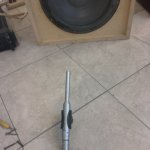
The idea was to get an overall impression of how little changing a woofer will actually do to a premade cabinet.
Since the drivers were so different, I shouldn't even have to do much special testing to see the impact but my tests showed little if any, I could have tested it with room interaction (which I did that afternoon) but it was very early morning around 4am when I started and didn't want to be running loud sweeps but new the tests were adequate to show my point.
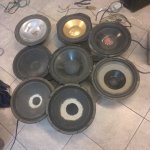
These were the tested woofers minus the gold one
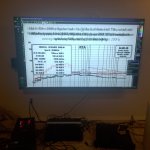
This is all tests layed over in one plot you can see the plots all start at the same point and you can see the SPL is the same
I didn't realize that saving the plots in REW would result in small pictures.
I took stills of the screen with my phone
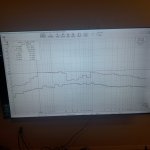
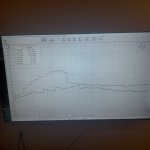
I have a bunch of these not sure how many I can post.
I did this same test using a Martin Logan Aerious and 7x 8" woofers and got the same no change until I added a second woofer mounted to the rear panel
They may have no resonances in the passband, but I am worried that the flexibility of the walls may have a spring effect that stores energy and give it back at high spl's, possibly smearing the impulse?My undamped 15mm ply enclosures (18" 700W PA drivers and minimal volume damping) have their first significant panel resonance at over 500Hz
Several comments about enclosure structural issues, which is not exactly related to bass response.Volume is the only significant factor, right?
Let's separate the questions/answers:
Shape affects bass response? No, unless you use very exotic dimensions. E.g., you need 64 liters and instead of building a 40x40x40cm, you build a 10x10x640cm looking more as an organ pipe. But if using comon proportions relative to a residential/studio dimensions such as 30x40x53cm, 20x30x106cm for the same 64 liters, all will probably sound the same.
Shape affects enclosure structure? Yes! Unbraced larger area panels will vibrate more than smalle area panels. So depending on the shape, a different bracing/treatment must be build. But any shape, if correctly braced, will resolve the vibrations, resonances etc. Of course, more bracing costs more, weights more, adds more complexities, take more internal volume etc. So chosing a specific shape can implicate in more or less complexity to resolve the structure of the enclosure. And yes, a bad enclosure structure can affect bass.
Last edited:
There will be a first mode at 160 Hz, so if this is still in the range of "bass" per your definition there may be a resonance peak, depending on position of driver and eventual ports.106cm
Zinda,I have to add that I've done many tests with select cabinets (most recently Klipsch Heresy) that seem to have a weak bass output in an effort to see how much deeper I could get that cabinet to play.
(I tested from 20 to 200Hz close mic about 10" from the cone with mic on the ground aimed up at the center of each driver) I did the test at low volume to keep room interaction out of the results around 80db.
Room interaction (direct to reflected ratio, modes and nodes) remain the same regardless of level.
Lower measurement level reduces signal to noise ratio.
The Klipsch Heresy's bass reflex port, which puts out most of the low bass, is located on the back of the cabinet.
Level drops 6dB per doubling of distance (outdoors, where low frequency tests should be conducted), your measurement choice distance could reduce the relative low frequency SPL by that amount or more.
The cabinet's lowest usable frequency (-6db point) is mainly set by the Fb (tuning frequency) response will be -3dB at Fb in a "flat" alignment, and drops at ~24dB per octave below.I have to conclude that as long as there's enough volume inside, the main factor that sets the cabinets lowest usable frequency (-6db point) is the proportions.
Drivers with different TS parameters (Fs, Vas, etc.) in the same enclosure will result in different alignments, various SPL at Fb.
If you measure them properly, you will find shape, other than extremely high aspect ratios "towers", will have little to do with low frequency output of a bass reflex enclosure.I'm going to make a small test coffin and run some 6" "subs" . I have about 20 different drivers to test. I won't be worried about perfect fit just hitting proportions while maintaining the same volumes and comparing rectangle boxes with same volumes to find out how much shape plays in low frequency output.
Art
an overall impression of how little changing a woofer will actually do to a premade cabinet.
Since the drivers were so different, I shouldn't even have to do much special testing to see the impact but my tests showed little if any
it was very early morning around 4am when I started and didn't want to be running loud sweeps but new the tests were adequate to show my point.
I was trying to briefly and more politely tell you that your test is flawed. You deviated from very well-established nearfield methods for low frequency measurement in order to also make a statement that contradicts very well-established enclosure modeling methods. If you want to attack an accepted model, it's helpful to use an accurate measuring method. You did not. Whether your test shows anything can't be judged by anyone else because of this.
There are strong reasons why nearfield measurements must be performed very close to the cone/dust cap in order to be accurate within their limits. A low signal level makes this even more important. These things are simply not negotiable if you want to measure low frequencies accurately in a normal sized room at home (assuming you want the response of the speaker alone and not that of the speaker plus room, noise, etc.).
Last edited:
The fact that the first mode is so high is proof of high stiffness.They may have no resonances in the passband, but I am worried that the flexibility of the walls may have a spring effect that stores energy and give it back at high spl's, possibly smearing the impulse?
- Home
- Loudspeakers
- Subwoofers
- Does cabinet shape affect bass response?